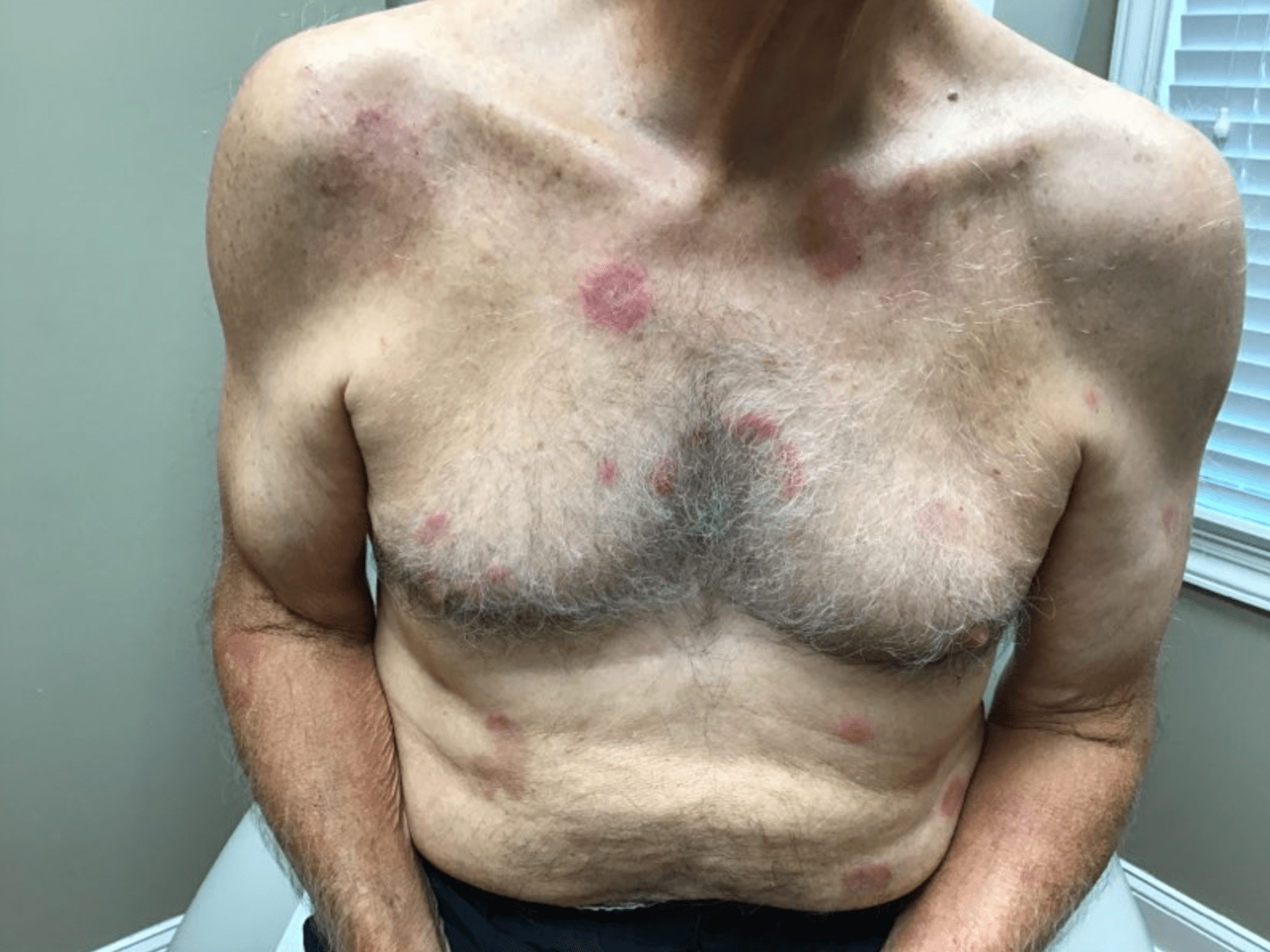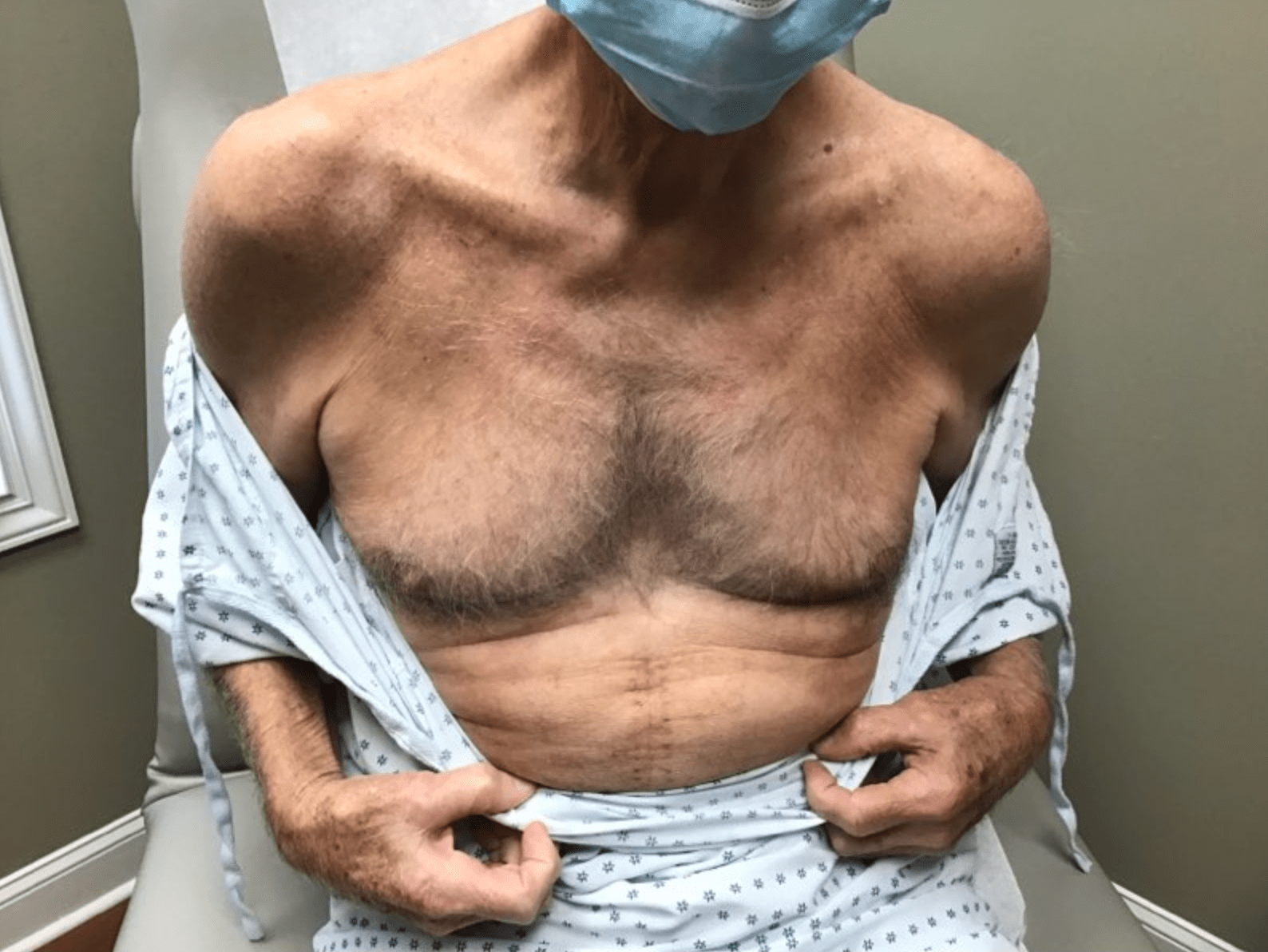Monday Poster Session
Category: Colorectal Cancer Prevention
P2671 - Erythema Annulare Centrifugum: A Dermatologic Suspicion for Malignancy
Monday, October 27, 2025
10:30 AM - 4:00 PM PDT
Location: Exhibit Hall

Joshua G. Fricker, MD
University of Alabama at Birmingham Hospital
Birmingham, AL
Presenting Author(s)
Joshua G. Fricker, MD1, Chase Tenewitz, MD2, John Cole, MD3, Jessica Beier, MD4
1University of Alabama at Birmingham Hospital, Birmingham, AL; 2Memorial Health University Medical Center, Savannah, GA; 3Cole Dermatology, Valdosta, GA; 4Tift Regional Medical Center, Tifton, GA
Introduction: Erythema annulare centrifugum (EAC), a dermatological lesion that typically presents as an annular, erythematous rash that enlarges centrifugally, then clears centrally. Although the pathogenesis of EAC is not currently fully understood, it is commonly characterized as a hypersensitivity reaction that occurs in congruence with a multitude of different entities: infectious diseases (viruses, bacteria and parasites) and drugs (chloroquine, cimetidine, aceclofenac). Additionally, EAC has been associated with underlying malignancies. This paraneoplastic phenomenon occurs significantly less frequently compared to the previously stated entities and has been designated as PEACE (paraneoplastic erythema annulare centrifugum eruption).
Case Description/
Methods: A 78 year-old male presented to his primary care physician (PCP) with erythematous scaly plaques with a serpiginous border distributed on the left lateral popliteal fossa, arms, legs, and neck. Unable to identify the rash, the PCP referred the patient to a dermatologist. Based on the clinical presentation of the lesion, the dermatologist prescribed a topical steroid treatment regimen. After two months, the patient returned to the dermatologist with only mild improvements of their rash. With biopsy confirmation, a diagnosis of EAC was then made.
Based on EAC’s possible association with malignancy and the patient’s lack of a past colonoscopy, a follow-up to a gastroenterologist for a colonoscopy was made. Through colonoscopic investigation, a mass was noted in the proximal transverse colon and a specimen was obtained using a jumbo cold biopsy forcep. After histological analysis, the specimen was determined to be moderately differentiated adenocarcinoma. Finally, general surgery performed a formal right hemicolectomy revealing a polypoid, ulcerated tumor measuring 5.5 x 4 x 2.5 cm with no local metastatic invasion. Resection of the tumor resulted in subsequent resolution of the EAC rash.
Discussion: While the most common etiologies of EAC are typically benign, it is critical for a physician to be aware that this rash can also occur in association with a paraneoplastic process. It is of utmost importance for the PCP to recognize this malignant association, relay the importance of proper cancer screening, and refer the patient for a prompt dermatology follow-up. With an early detection of PEACE, the underlying cancer can be detected at an earlier stage of the disease ultimately resulting in a better long-term prognosis for the patient.

Figure: Paraneoplastic Erythema Annulare Centrifugum Eruption shown on the torso from the initial presentation

Figure: Resolution of previously seen Paraneoplastic Erythema Annulare Centrifugum Eruption after resection of his colorectal adenocarcinoma (as evidenced by abdominal surgical scar)
Disclosures:
Joshua Fricker indicated no relevant financial relationships.
Chase Tenewitz indicated no relevant financial relationships.
John Cole indicated no relevant financial relationships.
Jessica Beier indicated no relevant financial relationships.
Joshua G. Fricker, MD1, Chase Tenewitz, MD2, John Cole, MD3, Jessica Beier, MD4. P2671 - Erythema Annulare Centrifugum: A Dermatologic Suspicion for Malignancy, ACG 2025 Annual Scientific Meeting Abstracts. Phoenix, AZ: American College of Gastroenterology.
1University of Alabama at Birmingham Hospital, Birmingham, AL; 2Memorial Health University Medical Center, Savannah, GA; 3Cole Dermatology, Valdosta, GA; 4Tift Regional Medical Center, Tifton, GA
Introduction: Erythema annulare centrifugum (EAC), a dermatological lesion that typically presents as an annular, erythematous rash that enlarges centrifugally, then clears centrally. Although the pathogenesis of EAC is not currently fully understood, it is commonly characterized as a hypersensitivity reaction that occurs in congruence with a multitude of different entities: infectious diseases (viruses, bacteria and parasites) and drugs (chloroquine, cimetidine, aceclofenac). Additionally, EAC has been associated with underlying malignancies. This paraneoplastic phenomenon occurs significantly less frequently compared to the previously stated entities and has been designated as PEACE (paraneoplastic erythema annulare centrifugum eruption).
Case Description/
Methods: A 78 year-old male presented to his primary care physician (PCP) with erythematous scaly plaques with a serpiginous border distributed on the left lateral popliteal fossa, arms, legs, and neck. Unable to identify the rash, the PCP referred the patient to a dermatologist. Based on the clinical presentation of the lesion, the dermatologist prescribed a topical steroid treatment regimen. After two months, the patient returned to the dermatologist with only mild improvements of their rash. With biopsy confirmation, a diagnosis of EAC was then made.
Based on EAC’s possible association with malignancy and the patient’s lack of a past colonoscopy, a follow-up to a gastroenterologist for a colonoscopy was made. Through colonoscopic investigation, a mass was noted in the proximal transverse colon and a specimen was obtained using a jumbo cold biopsy forcep. After histological analysis, the specimen was determined to be moderately differentiated adenocarcinoma. Finally, general surgery performed a formal right hemicolectomy revealing a polypoid, ulcerated tumor measuring 5.5 x 4 x 2.5 cm with no local metastatic invasion. Resection of the tumor resulted in subsequent resolution of the EAC rash.
Discussion: While the most common etiologies of EAC are typically benign, it is critical for a physician to be aware that this rash can also occur in association with a paraneoplastic process. It is of utmost importance for the PCP to recognize this malignant association, relay the importance of proper cancer screening, and refer the patient for a prompt dermatology follow-up. With an early detection of PEACE, the underlying cancer can be detected at an earlier stage of the disease ultimately resulting in a better long-term prognosis for the patient.

Figure: Paraneoplastic Erythema Annulare Centrifugum Eruption shown on the torso from the initial presentation

Figure: Resolution of previously seen Paraneoplastic Erythema Annulare Centrifugum Eruption after resection of his colorectal adenocarcinoma (as evidenced by abdominal surgical scar)
Disclosures:
Joshua Fricker indicated no relevant financial relationships.
Chase Tenewitz indicated no relevant financial relationships.
John Cole indicated no relevant financial relationships.
Jessica Beier indicated no relevant financial relationships.
Joshua G. Fricker, MD1, Chase Tenewitz, MD2, John Cole, MD3, Jessica Beier, MD4. P2671 - Erythema Annulare Centrifugum: A Dermatologic Suspicion for Malignancy, ACG 2025 Annual Scientific Meeting Abstracts. Phoenix, AZ: American College of Gastroenterology.
